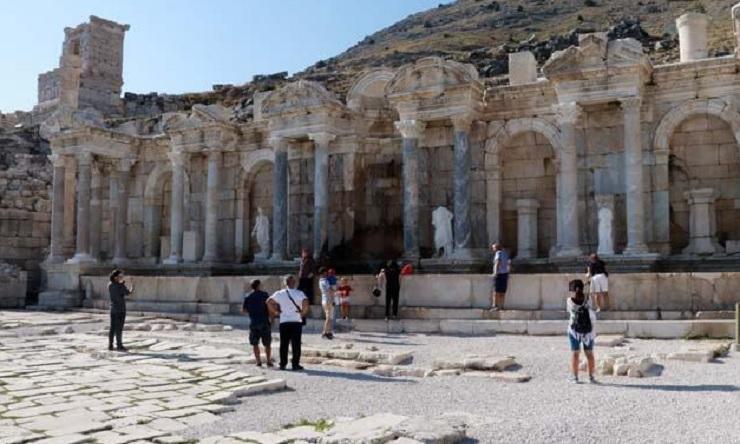Burdur’s museums, archaeological sites fascinate visitors
BURDUR – Demirören News Agency

Turkey’s southern province of Burdur welcomes thousands of local and foreign visitors every year thanks to its historical sites. Home to ancient cities such as Kibyra and Sagalassos that contains dozens of historical artifacts, Burdur also attracts attention with its museums, which welcomed 249,000 people in 2019. Although the number of visitors decreased due to the pandemic last year, the museum and archaeological sites in Burdur still amaze visitors.
Among the attractions in the city are the Burdur Archeology Museum, the ancient city of Kibyra, which is located at an altitude of 1,350 meters and covered with juniper and cedar forests, and the ancient Roman city of Sagalassos, which was established at an altitude of 1,600 meters in the Ağlasun district in 3,000 B.C.
The museums and archaeological sites, which were closed to visitors at the end of March last year within the scope of coronavirus measures, started to welcome visitors again with the normalization steps taken on June 1.
Last year, 140,000 local and foreign tourists visited the museums and archaeological sites in Burdur, with a decrease of 44 percent compared to the previous year. This figure was 250,000 in 2019.
The ancient city of Sagalassos, which welcomed 80,000 visitors in 2019, was visited by 42,000 people in 2020. The Burdur Archeology Museum entertained 35,000 people in 2019 but hosted only 8,000 visitors in 2020, while the Natural History Museum in the city center, which hosted 7,000 visitors in 2019, hosted only 3,000 people last year.
İnsuyu Cave, Turkey’s first cave that opened to tourism, hosted 65,000 people last year, while this figure was 114,000 in 2019.
The number of visitors in the ancient city of Kibyra increased last year compared to 2019. While 15,000 people visited Kibyra in 2019, this number reached 22,000 last year.
The first stop for holidaymakers in the city is the Burdur Archeology Museum, which was established in 1969. More than 57,000 works from the Persian, classical, Hellenistic, Roman, Byzantine, Seljuk and Ottoman periods and nearly 4,000 ethnographic works adorn the museum.
The museum hosted 35,000 people in 2019, but this figure dropped down to just 8,000 in 2020 due to the measures taken in line with the pandemic.
Another stop for holidaymakers in Burdur, the smallest city of the Western Mediterranean region, is the ancient city of Sagalassos in Ağlasun.
A fountain named after the Antonines, a family of Roman emperors who built it in 160-180 A.D in the ancient city, is one of the most fascinating places to visit. In the Antonines Fountain, the natural spring water, once drawn from Ağlasun Mountain by ancient waterways, still continues to flow like a small waterfall today.
The magnificent fountain in the north of the Upper Agora is 28 meters in length and 9 meters in height. In front of the fountain, there is an 81-cubic-meter pool made of seven different colored stones.
Excavation and restoration work started in the fountain in 1998, and it started operating again in 2010. Though the originals of the four sculptures unearthed during the excavations are exhibited in the Burdur Archeology Museum, their exact imitations were placed in the fountain.
People who visit often drink water from the fountain, which is thought to have been built by Titus Flavius Severanus Neon and his wife, the most important benefactor of Sagalassos.
While 80,000 local and foreign tourists visited the ancient city of Sagalassos in 2019, this number was 42,000 in 2020 due to the negative impact of the pandemic.
The 2,300-year-old Kibyra, also known as the “City of Gladiators,” draws attention with its gigantic monumental structures. The city is home to Turkey’s longest ancient friezes depicting the gladiators.
The city has a stadium with a capacity of 10,000 people, built in the Roman and Byzantine architectural traditions. Apart from the late Roman bath, agoras, main street, a huge theater for 9,000 people and underground chamber tombs, it is also home to an orchestra section covered with Medusa mosaic, which is unique in the world.
The ancient city, which entered the UNESCO World Heritage Tentative List in 2016, welcomed 15,000 people in 2019 and 22,000 people in 2020.
Located 13 kilometers away from Burdur, İnsuyu Cave is a 597-meter horizontal cave that opened to tourism in 1965 on the Burdur-Antalya highway. The stalactites and stalagmites, which were formed as a result of the melting and erosion of the Karstic structure over time, attract the attention of visitors the most.
Around 114,000 people visited the caves in 2019, but due to the negative impact of the pandemic, the caves entertained some 65,000 people last year.
















